Next Generation of 3PAR
If you were at HPE Discover in June (2019) or if you follow HPE technology development, then I know you’ve heard about HPE Primera, HPE’s newest Tier-0 storage array and an evolution of the HPE 3PAR StoreServ Family. Since the announcement, I’ve been getting a few questions about Primera from our clients. It seemed appropriate to answer some of those questions in this month’s post.
What is HPE Primera?
HPE Primera is a Tier-0 enterprise storage solution designed with extreme resiliency (100% uptime guarantee) and performance targeted at the most critical workloads that simply cannot fail. The key word here is “critical”. HPE Primera is not intended to be a default replacement for the HPE 3PAR StoreServ 8000 and 9000 arrays. Your requirements could certainly dictate an HPE Primera solution, but, Nimble (HPE Tier-1 solution) may be a better fit.
At launch, HPE Primera includes three models: HPE Primera 630, HPE Primera 650, and HPE Primera 670. Each model is available as an all-flash version (A630, A650 and A670). These models come in 2 and 4-Node versions. In the graphic below, you can see how the current HPE Primera models might line up with the HPE 3PAR StoreServ and Nimble Models:
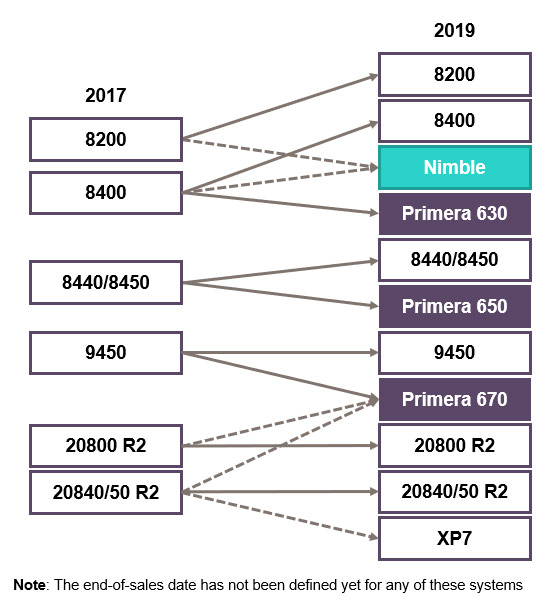
Isn’t Primera just the latest 3PAR Array?
Well, in many ways, the answer is yes. But, more precisely it is an Evolution of the HPE 3PAR StoreServ Family. It is the same in that:
- You can have up to 4-Nodes in a Single Array.
- The Nodes are Active/Active.
- The architecture for each node is based on Intel Processors, ASICs and Cache.
- There are all flash and Hybrid options.
- They all support Thin Provisioning, Deduplication, and Compression.
- Many of the feature sets are identical (i.e., Remote Copy, Virtual Copy, Multi-tenancy, Virtual Domains, etc.) across the arrays.
- Management is done through the SSMC Interface.
- There is a Service Processor to manage notification, upgrades, phone home to HPE, etc.
- Both come with all-inclusive software (no separate licenses).
- Both are all integrated with HPE InfoSight.
HPE Primera is different from the 3PAR StoreServ arrays in these ways:
- The Gen 5 ASIC in the HPE 3PAR StoreServ was designed for all-flash and uses a distributed cache where the CPU utilizes the Control Cache and the ASIC the Data Cache. The HPE Primera is designed for NVMe and has a Unified Cache.
- The Service Processor on the HPE 3PAR StoreServ is a separate physical or virtual appliance. On the HPE Primera the Service Processor is integrated into the Nodes.
- In the initial launch the HPE Primera will only support Fibre Channel Connectivity.
- The HPE 3PAR StoreServ supports CPG’s utilizing RAID 0, 1, 5 or 6. The HPE Primera utilizes only RAID 6.
- Because of the significant change in node architecture and some advancement in features, HPE Primera uses a different InForm OS Code Base than the HPE 3PAR StoreServ Family of arrays.
Is the HPE 3PAR StoreServ Family (8000, 9000) End of Life now?
The short answer is No. HPE has not announced the End of Life (EOL) for the HPE 3PAR StoreServ. When an EOL announcement is made, customers will still be able to purchase them up to 6 months afterward. Hardware upgrades will continue to be made available up to 3 years after the announcement and support will be provided for 5 years after the EOL announcement. This is HPE’s normal cycle when an EOL is announced for an enterprise solution and it will hold true for the HPE 3PAR StoreServ family.
If I’m looking at a 3PAR now, shouldn’t I just go with the Primera instead?
Not necessarily. Remember, there has been no EOL announcement made for the HPE 3PAR StoreServ. And you’ll have 5 years of support once the announcement is made. Also, the Primera is designed for the most Critical workloads in terms of availability and performance requirements. The HPE 3PAR StoreServ or a Nimble Array may line up more appropriately with your unique requirements.
In Summary
HPE Primera is an evolution of the HPE 3PAR StoreServ family and it will fill the needs of Tier-0 workloads. While many of the features and functionality are the same between Primera and StoreServ families, there are also significant differences in architecture. For many, the current HPE 3PAR StoreServ Family (8000/9000) may still be the right fit. For others, a Nimble solution may be the best solution. Contact Zunesis to find the right storage solution for your organization.
As the CEO of Zunesis, I am fond of saying “get beyond talking and PowerPoint slides and find some way to take action”. Everyone can talk a good game, but far fewer can actual design and implement successful IT solutions on-time and within budget. I feel like customers are tired of watching our lips flap and instead want IT Solution Providers to show them actual tangible value. It seems that all customers are from Missouri these days “the show me state”.
In 2015, Zunesis made the decision to invest heavily in a Technology Lab so we could show our clients and prospects actual infrastructure solutions, software solutions and management platforms. The ability to show technology working, instead of just talking about it, has been a big benefit to our clients. Building out a professional technology lab has been expensive, but the rewards stretch beyond just show and tell. The Lab has also proven beneficial to our Solution Architects who constantly use the Zunesis Lab to hone their skills on newer technology and test specific upgrade paths for software. The IT world is always changing and we want to make sure that we have tested specific technology and integration paths before we recommend them and before we go on site for an implementation.
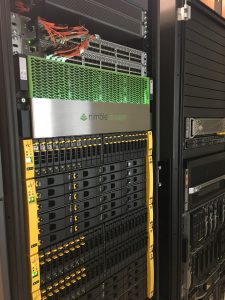
Zunesis – Technology Lab featuring Nimble Storage
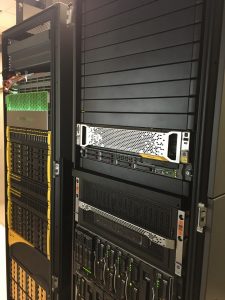
Zunesis Technology Lab
Zunesis has been a Platinum Partner with Hewlett Packard Enterprise (HPE) for 13+ years. As a result, most of the technology in our lab is HPE. Today we have 3 different 3Par Storage Arrays, a Nimble Array, a C7000 Chassis that includes a variety of HPE Servers (Generation 7, 8 and 9) and OneView for overall systems management. The Lab has several Brocade Fibre Channel Switches and Moonshot servers. Within the Lab, we run VMware and Veeam software and have connections to the Microsoft Cloud – Azure. In the coming months, we will be installing new technology in the Lab including:
- Simplivity 2 node
- HPE Gen10 servers
- Aruba switches top of rack
- Extreme network top of rack switches
In the not too distant future, we will replace the C7000 Chassis with an HPE Synergy frame.
Our plans are to continue to invest in our Lab so we can show clients and prospects the actual technology, instead of just talking about it. Furthermore, the Lab is another way we can invest in the on-going technical training and proficiency of our Solution Architects at Zunesis. If you would ever like to stop by for a technology demonstration or just to talk about what you are trying to accomplish in your business, Contact us and would be happy to have you come by for a visit.
In recent months, HPE has announced two acquisitions that significantly impact their online storage portfolio. In January, it was announced that HPE would be acquiring SimpliVity, a leader in the hyperconverged space. Just two months later, in March, we heard that HPE would be acquiring Nimble, a manufacturer of all-flash and hybrid-flash storage solutions backed by a powerful predictive analytics tool called InfoSight. The acquisition of these two solutions gives HPE one of the strongest storage portfolios in the industry.
The HPE online storage portfolio now includes the following:
• MSA
• StoreVirtual (LeftHand)
• Nimble
• SimpliVity
• 3PAR
So, with so many options, the questions you may be asking are, “Where does each fit into my IT Infrastructure?” or “How do I determine which of these is right for my environment?” There is certainly some overlap amongst these options, but there are also clear reasons why you might choose one over the other.
In this post, I want to provide a summary of each of the solutions and include a few thoughts on why you might consider each as a solution for your environment. I will not cover the XP in this post because it is a solution that has a very narrow set of use cases, and most infrastructure needs will be met by the other online storage solutions in the HPE portfolio.
The solutions are organized here from entry-level to enterprise class.
MSA
 The MSA is a family of storage solutions that’s been around for some time and continues to evolve as storage technologies change. This is generally considered an entry-level array. The MSA two controller array offers Block storage over SAS, Fibre Channel, or iSCSI. Despite its entry-level categorization, the MSA is a solution that can provide up to 960TB of RAW capacity and nearly 200,000 IOPS.
The MSA is a family of storage solutions that’s been around for some time and continues to evolve as storage technologies change. This is generally considered an entry-level array. The MSA two controller array offers Block storage over SAS, Fibre Channel, or iSCSI. Despite its entry-level categorization, the MSA is a solution that can provide up to 960TB of RAW capacity and nearly 200,000 IOPS.
In addition to the capacity and performance, this array provides some impressive features, including:
– Thin Provisioning
– Automated Tiering
– Snapshots
– Array-based Replication
– Quality of Service
Consider the MSA if you are trying to meet the needs of a few hosts with a predictable workload profile. This solution is designed with smaller deployments in mind and where affordability is a key factor. If you are looking for deduplication, compression, or plan to scale your environment significantly, the MSA is not for you. We have used the MSA for small VMware environments and as Disk Targets in a backup solution.
StoreVirtual
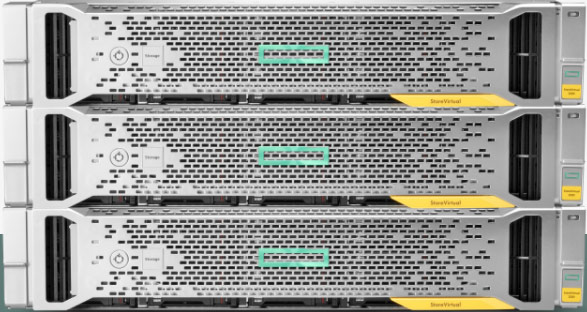 StoreVirtual defines an operating system for providing scale-out, software defined storage solutions. StoreVirtual is based on the LeftHand operating system. LeftHand was a company HP acquired in October of 2008 to give them an iSCSI solution in their portfolio. The LeftHand Operating System is designed to run on most x86-based hardware and can be deployed as a virtual machine, a hyperconverged appliance, or as a dedicated storage array.
StoreVirtual defines an operating system for providing scale-out, software defined storage solutions. StoreVirtual is based on the LeftHand operating system. LeftHand was a company HP acquired in October of 2008 to give them an iSCSI solution in their portfolio. The LeftHand Operating System is designed to run on most x86-based hardware and can be deployed as a virtual machine, a hyperconverged appliance, or as a dedicated storage array.
Regardless of how it is deployed, the StoreVirtual solution provides block storage over iSCSI or Fibre Channel. Capacities can vary depending on the method that is deployed but can go up to 576TB of RAW capacity on the SV3200 Appliance Storage Node.
The StoreVirtual uses an all-inclusive licensing model, and the feature set includes:
– Thin Provisioning
– Automated Tiering
– Snapshots
– Array-based Replication
– Multi-site Stretch Clusters
– Built-in Reporting
Like the MSA, StoreVirtual is intended for smaller deployments with predictable workloads. As a scale-out solution, the StoreVirtual provides an easy path for increasing capacity and performance simultaneously by adding one or more StoreVirtual Nodes. The StoreVirtual solution is a relatively affordable solution for the features it provides. And, if you are looking to take advantage of existing compute and storage hardware, StoreVirtual may be a good choice. We see the StoreVirtual solutions deployed in smaller to mid-sized virtual environments.
SimpliVity
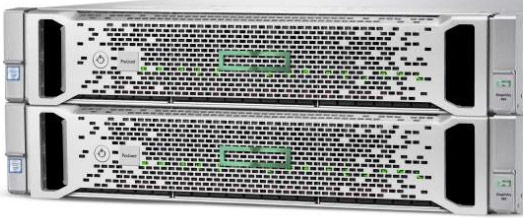 To be clear, SimpliVity is not a standalone, online storage solution. It is a hyperconverged solution that provides Storage, Compute, and Networking services in one converged solution. I am including it in these summaries because it includes storage as an important part of the overall solution and would be an alternative to needing to provide a separate storage solution for your VMware environment.
To be clear, SimpliVity is not a standalone, online storage solution. It is a hyperconverged solution that provides Storage, Compute, and Networking services in one converged solution. I am including it in these summaries because it includes storage as an important part of the overall solution and would be an alternative to needing to provide a separate storage solution for your VMware environment.
SimpliVity is specifically designed to provide all the infrastructure beneath the hypervisor layer. At this time, it is specifically for VMware environments. As a converged solution, SimpliVity provides everything you would need to support your environment. (Yes, that means backup as well!)
Here is a list of the features you’ll find in a SimpliVity solution:
– Servers & VMware
– Storage Switch
– HA Shared Storage
– Backup & Dedupe
– WAN Optimization
– Cloud Gateway
– SSD Array
– Storage Caching
– Data Protection Apps (Backup & Replication)
– Deduplication
– Compression
This solution is going to be more expensive than the MSA or StoreVirtual offerings; but, again, it provides all the infrastructure for your VMware environment. It’s more than just a storage solution. So, if you are looking to consolidate your infrastructure significantly and the workloads you are supporting have all been virtualized on VMware, this solution may be worth looking at for you.
Nimble
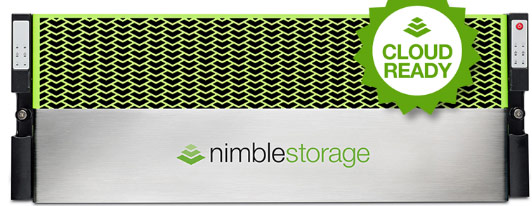 The Nimble solutions offer Block storage in all-flash and hybrid-flash models delivered over iSCSI or Fibre Channel. The current offering from HPE will provide up to 294TB of RAW capacity on the hybrid-flash solution. Of course, compression and deduplication will provide much greater effective capacity dependent on data types.
The Nimble solutions offer Block storage in all-flash and hybrid-flash models delivered over iSCSI or Fibre Channel. The current offering from HPE will provide up to 294TB of RAW capacity on the hybrid-flash solution. Of course, compression and deduplication will provide much greater effective capacity dependent on data types.
The all-inclusive features of the Nimble family include:
– Thin Provisioning
– Automated Tiering
– Application Aware Snapshots
– Deduplication (all-flash)
– Quality of Service (all-flash)
– Array-based Replication
– Encryption
– InfoSight Predictive Analytics
This solution is designed to handle mixed-workloads and is perfect for mid-sized virtualized environments. InfoSight Predictive Analytics is a significant part of this solution, and I wouldn’t be surprised if it were integrated with other HPE storage solutions in the future.
Taken directly from the HPE QuickSpecs, the InfoSight Analytics provide:
– Proactive resolution. InfoSight automatically predicts and resolves 86% of problems before you even know there is an issue.
– Solves storage and non-storage problems. By collecting and correlating sensors across the infrastructure stack, InfoSight uncovers problems spanning from storage to VMs. In fact, 54% of the problems InfoSight resolves are outside of storage.
– Prevents known issues with infrastructure that learns. If a problem is detected in one system, InfoSight begins to predict the issue and inoculate other systems. Every system gets smarter and more reliable through collective installed base insights.
– The support you’ve always wanted. Automation and proactive resolution put the focus on prevention, streamlining the process, and connecting you directly to support expertise. No more answering routine support questions, sending log files, or attempting to recreate issues.
Nimble should be a consideration for any virtualized environment where you are looking for ease of use, great reporting, and performance.
3PAR
 Of course, this has been the workhorse for the enterprise storage offering from HPE since 2010. Depending on the model, the 3PAR Solution can start with 2 Controllers and go up to 8 Controllers for a single array. The 3PAR has both a hybrid and an all-flash solution. Capacities can scale to 6PB RAW in the new 9000 series of the 3PAR family. The 3PAR array delivers Block over iSCSI and Fibre Channel and can also supports SMB, NFS, and FTP/FTPS natively.
Of course, this has been the workhorse for the enterprise storage offering from HPE since 2010. Depending on the model, the 3PAR Solution can start with 2 Controllers and go up to 8 Controllers for a single array. The 3PAR has both a hybrid and an all-flash solution. Capacities can scale to 6PB RAW in the new 9000 series of the 3PAR family. The 3PAR array delivers Block over iSCSI and Fibre Channel and can also supports SMB, NFS, and FTP/FTPS natively.
The all-inclusive feature set includes:
– Thin Provisioning
– Thin Deduplication
– Thin Compression
– Snapshots
– Array-based Replication (add-on license)
– File Persona (SMB, NFS, FTP/FTPS)
– Automated Tiering
– Flash Cache
– Quality of Service
– Non-disruptive LUN Migration
– Array to Array Migration
– Reporting
– Multi-Tenancy
The 3PAR Array should be considered for a multi-workload environment where performance, availability, and scale are the top priorities.
Which One Is Right for You?
As mentioned at the beginning of the post, the goal here was to provide a summary of the primary online storage solutions now offered by HPE and to give a little guidance on where they might fit. Each of these solutions represent a different architecture, and those architectures should be understood clearly before making any final decisions. At Zunesis, we can help you understand which of these solutions might fit your needs and can walk you through the architectures of each.
I’m sure there will be no surprised reaction when I state that we live in a data driven world. For proof you have to look no further than the people around you as you go throughout your day. Unless you’re hiking through the desert, you’re going to see many people with their heads down, looking at their smartphones as the read and send emails, texts, and tweets. From this same smartphone they will search for information, store notes, review documents, and the list goes on and on (what can’t a smartphone do these day?!)
Here’s the thing about this: All of the information they are creating and accessing is stored somewhere. It is this unabated demand for immediate and reliable data access that has created an unprecedented evolution in Storage technology. And it is the technology industry’s response (an explosion of Storage options) that makes the task of choosing your next Storage Array so difficult.

As businesses look to refresh their storage technology today, they are met with a dizzying menu of features including thin provisioning, deduplication, compression, iSCSI, File, Fibre Channel, All Flash, Hybrid, Tiering, etc.
Of course, the question is which of these features will be relevant for any given environment. The final answers will, of course, vary by environment. However, even after you’ve assessed your needs and ranked your requirements, you will still be faced with an increasingly crowded field of solution options from both established manufacturers and those who are new to the industry.
In my view, if you aren’t including HPE 3PAR StoreServ in your short-list, you may want to reconsider. Not only is HPE an established manufacturer, the 3PAR StoreServ is a mature array family and will match all the features/functionality of its competitors.
What’s more, the family of arrays included in the StoreServ solutions include options that will fit price/performance for Entry level, Midrange, and Enterprise arrays – all of these with the same features and functionalities. Furthermore, you’ll find both All Flash and Hybrid models to suit your requirements.
Here are just a few of the features and functionality you’ll find in the HPE 3PAR StoreServ family:
- Thin Provisioning – Up to 50% reduction in your storage footprint if you are fully provisioned today.
- Dynamic Optimization – The ability to migrate entire volumes to different tiers or RAID levels non-disruptively.
- Adaptive Optimization – The ability to migrate volumes at the sub-volume level based on policies you choose. This too is done non-disruptively.
- Deduplication – The ability to eliminate duplicate blocks and reduce storage footprint, in addition to what Thin Provisioning provides.
- Federation – The ability to migrate volumes/workloads across arrays non-disruptively.
- Priority Optimization – The ability to prioritize IOPS, Throughput, and Latency on a per volume basis.
- Data Encryption – Encryption of data-at-rest.
- File Persona – Serve data via CIFS and NFS directly from the array.
- Fibre Channel and iSCSI
- Detailed Reporting
- Application Integration – For Vmware, Hyper-V, SQL, Exchange, and Oracle.
 And, if you want some validation of how well the 3PAR Family stacks up against its competition, you may want to look at the publications from DCIG, Storage Magazine, Gartner, and TechTarget. Links to these publications and more detailed information about the HPE 3PAR StoreServ can be found at www.hpe.com/us/en/storage/3par.html.
And, if you want some validation of how well the 3PAR Family stacks up against its competition, you may want to look at the publications from DCIG, Storage Magazine, Gartner, and TechTarget. Links to these publications and more detailed information about the HPE 3PAR StoreServ can be found at www.hpe.com/us/en/storage/3par.html.
And, of course, Zunesis is ready to help you understand the benefits of 3PAR for your environment. In fact, if you’d like to spend some time on a 3PAR array, we have three HPE 3PAR StoreServ arrays in our Lab and would love to host you for a POC in our Englewood, CO facility. Please contact us if you are interested in taking a closer look at this technology.

